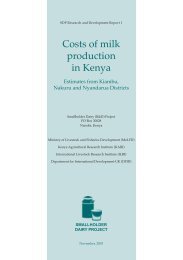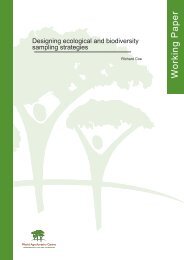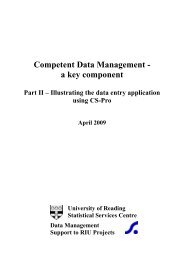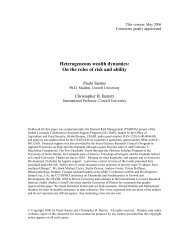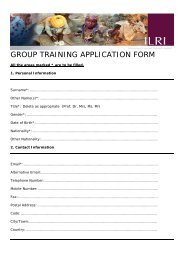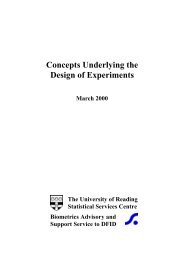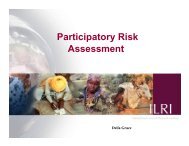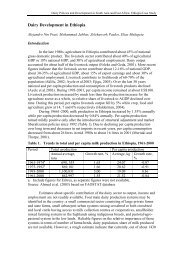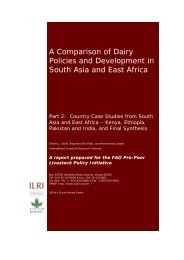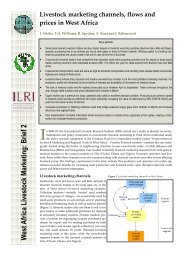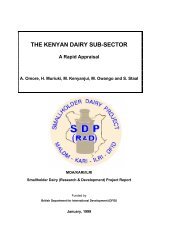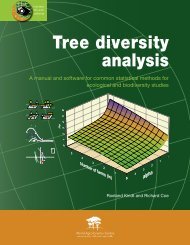Integrated perennial tree crop–large and small rum<strong>in</strong>ant systems are important <strong>in</strong> Indonesia (rubber, oilpalm and coconut), the Lao PDR (teak), Malaysia (rubber and oil palm) Myanmar (teak), the Philipp<strong>in</strong>es(coconut and fruit), South Ch<strong>in</strong>a (coconut and rubber), Thailand (coconut, rubber and fruit) and Vietnam(rubber). Preferred animal options under rubber are small rum<strong>in</strong>ants, and large rum<strong>in</strong>ants under oil palm.Under coconut, both large and small rum<strong>in</strong>ants are options. The presence <strong>of</strong> a range <strong>of</strong> perennial tree crops<strong>in</strong> the uplands <strong>of</strong> many countries provides a common thread for the development <strong>of</strong> <strong>in</strong>tegrated systems<strong>in</strong>volv<strong>in</strong>g rum<strong>in</strong>ants.Inadequate animal numbersAdequate livestock numbers are a vital prerequisite for the development <strong>of</strong> improved animal productionsystems. In the Philipp<strong>in</strong>es, Indonesia and Malaysia there is a serious constra<strong>in</strong>t <strong>of</strong> <strong>in</strong>adequate animalnumbers. Accord<strong>in</strong>gly, large numbers <strong>of</strong> animals are imported from Australia for fatten<strong>in</strong>g at some cost t<strong>of</strong>oreign exchange reserves. In Thailand, there is no <strong>of</strong>ficial importation <strong>of</strong> animals, but a significantclandest<strong>in</strong>e trade <strong>in</strong> live animals occurs <strong>in</strong> neighbour<strong>in</strong>g countries for which there are no statistics. There isno stratification <strong>of</strong> the <strong>in</strong>dustry. In sub-Saharan Africa and South America, the traditional breed<strong>in</strong>g-rear<strong>in</strong>gareas are the vast rangelands <strong>of</strong> the drier zones or those on acid, <strong>in</strong>fertile soils, where a pool <strong>of</strong> animals existsfor fatten<strong>in</strong>g <strong>in</strong> other areas. Such extensive rangelands are not available to the same extent <strong>in</strong> South-East Asia,and smallholders have no f<strong>in</strong>ancial <strong>in</strong>centive to become <strong>in</strong>volved <strong>in</strong> these operations as it takes a long periodfor <strong>in</strong>come to be generated. In the Philipp<strong>in</strong>es, the large ranches that formerly supplied smallholders withbreed<strong>in</strong>g and fatten<strong>in</strong>g stocks have been broken up as a result <strong>of</strong> the land reform programme.Feed resources and feed<strong>in</strong>g systemsAvailable feedsFour ma<strong>in</strong> categories <strong>of</strong> feed can be identified <strong>in</strong> all <strong>of</strong> the countries: forages (native and improved grasses,herbaceous legumes, and multipurpose trees), crop residues, AIBP and NCFR. <strong>Crop</strong>s grown specifically forrum<strong>in</strong>ants, <strong>in</strong>clud<strong>in</strong>g improved grasses and legumes, represent a relatively small component <strong>of</strong> the availablefeed resources. Variable sizes <strong>of</strong> native grasslands exist <strong>in</strong> the different countries, with the largest areas found<strong>in</strong> Indonesia (ma<strong>in</strong>ly Irian Jaya, Kalimantan, Maluku, Nusa Tenggara, Sumatera and Timtim). Thesegrasslands, although <strong>of</strong> poor quality, provide graz<strong>in</strong>g for sizeable populations <strong>of</strong> buffaloes, cattle and smallrum<strong>in</strong>ants. Smaller areas are found <strong>in</strong> Cambodia, the Lao PDR (the savannahs <strong>of</strong> Xieng Khouang Prov<strong>in</strong>ce),Malaysia, north-east Thailand and Vietnam. In the Philipp<strong>in</strong>es, native grasslands also exist but support lowcarry<strong>in</strong>g capacities (ADB 1994). Pastures <strong>in</strong> fallows (<strong>in</strong>clud<strong>in</strong>g stubble graz<strong>in</strong>g) are also a very valuableroughage source for cattle and buffaloes.Forage resources under perennial tree crops are <strong>of</strong>ten underutilised. New developments <strong>in</strong> plant<strong>in</strong>gtechniques (e.g. double-hedgerow plant<strong>in</strong>g <strong>in</strong> rubber) could further extend the availability <strong>of</strong> adequate feedby reduc<strong>in</strong>g shad<strong>in</strong>g. Under coconut, pasture production is generally feasible throughout the life <strong>of</strong> theplantation, as light transmission does not fall to the very low levels associated with rubber or oil palm.Important forage resources also exist <strong>in</strong> forests <strong>in</strong> many countries <strong>in</strong> the region. Although significant workhas been conducted over many years on the development <strong>of</strong> shade-tolerant forage species, little work hasbeen conducted on the use <strong>of</strong> herbage and the supplementation <strong>of</strong> the fluctuat<strong>in</strong>g forage supply with availableAIBP such as palm kernel cake.Inventories <strong>of</strong> types and quantities <strong>of</strong> feeds exist for Indonesia, Malaysia and the Philipp<strong>in</strong>es, but areabsent for the Mekong countries and South Ch<strong>in</strong>a. Such <strong>in</strong>ventories, along with tables <strong>of</strong> feed composition,are approximations. Nevertheless, they do provide guidel<strong>in</strong>es for the development <strong>of</strong> feed<strong>in</strong>g strategies. Inall countries visited, opportunities exist for more efficient use to be made <strong>of</strong> crop residues, AIBP and NCFR,particularly dur<strong>in</strong>g critical periods <strong>of</strong> feed shortage <strong>in</strong> the dry season. Currently, their present use is limitedby a number <strong>of</strong> factors that <strong>in</strong>clude total availability, seasonality <strong>of</strong> supply, type and quality <strong>of</strong> the feed,production site, transportation, storage and conservation.
Presently, much <strong>of</strong> the vegetable prote<strong>in</strong> meals are exported to Europe and North America, whilstthose rema<strong>in</strong><strong>in</strong>g are fed to non-rum<strong>in</strong>ants. Examples are palm kernel cake, fish meals and leaf-meals.Therefore, forage legumes are, potentially, the more important source <strong>of</strong> prote<strong>in</strong>s for rum<strong>in</strong>ants. The ma<strong>in</strong>emphasis has been to provide prote<strong>in</strong> from perennial herbaceous legumes <strong>in</strong> re<strong>in</strong>forced native grasslands,<strong>in</strong> mixed pastures, and <strong>in</strong> pure stands <strong>in</strong> fodder banks. Environmental adaptation, biomass yield and prote<strong>in</strong>production have been the ma<strong>in</strong> criteria for legume selection and improvement. With multipurpose trees,there has been an overemphasis on Leucaena leucocephala, and not enough attention has been given tothe wider use <strong>of</strong> other genera (e.g. Gliricidia, Erythr<strong>in</strong>a, Calliandra) <strong>in</strong> crop–animal systems. Studies onmultipurpose trees were lack<strong>in</strong>g especially <strong>in</strong> the Mekong countries. Accord<strong>in</strong>gly, important opportunitiesexist for <strong>in</strong>creased research on multipurpose trees, <strong>in</strong>clud<strong>in</strong>g their use for feed and enhanc<strong>in</strong>g soil fertility,and the identification <strong>of</strong> niches for establishment <strong>in</strong> smallholder systems. Much research has beenundertaken <strong>in</strong> Ch<strong>in</strong>a, Indonesia, Malaysia, Thailand and Vietnam on the development and use <strong>of</strong>mult<strong>in</strong>utrient molasses-urea blocks <strong>in</strong> order to provide a better balance <strong>of</strong> nutrients, although availabilityand cost are <strong>of</strong>ten limitations to their <strong>in</strong>creased use.In most <strong>of</strong> the countries visited, particularly <strong>in</strong> Indonesia, the Philipp<strong>in</strong>es, Thailand and Vietnam,component-technology <strong>in</strong>terventions have tended to be ma<strong>in</strong>ly <strong>in</strong> the area <strong>of</strong> feed resources and nutrition. Inthe Philipp<strong>in</strong>es, for example, this is reflected <strong>in</strong> the research on crop–animal systems where 19 out <strong>of</strong> a total<strong>of</strong> 24 studies were <strong>in</strong>volved directly with feeds and nutrition, with generally beneficial and cost-effectiveresults (Appendix 1, the Philipp<strong>in</strong>es). However, what is not clear from these studies is the extent <strong>of</strong> theadoption <strong>of</strong> the improved technology.Considerable research has been conducted <strong>in</strong> all countries, notably Ch<strong>in</strong>a, Indonesia, the Philipp<strong>in</strong>es,Thailand and Vietnam, on the treatment <strong>of</strong> rice straw with urea or ammonia. A vast body <strong>of</strong> <strong>in</strong>formation hasbeen accumulated <strong>in</strong> the ASEAN sub-region and Vietnam on the improvement <strong>of</strong> digestibility and nutritivevalue for rum<strong>in</strong>ants. However, the adoption <strong>of</strong> this technology at the farm level has been very poor for avariety <strong>of</strong> reasons, <strong>in</strong>clud<strong>in</strong>g economic and social relevance. Research on technology delivery at farm leveland on the assessment <strong>of</strong> social, economic and environmental impact is very weak. The participation <strong>of</strong>farmers <strong>in</strong> the development <strong>of</strong> appropriate research work cannot be over-emphasised.Feed<strong>in</strong>g systemsRum<strong>in</strong>ant feed<strong>in</strong>g systems are based on unrestricted graz<strong>in</strong>g, tether<strong>in</strong>g or stall-feed<strong>in</strong>g. Free graz<strong>in</strong>g,sometimes under the control <strong>of</strong> herders, was common <strong>in</strong> countries with native grasslands and fallows.Tether<strong>in</strong>g and stall-feed<strong>in</strong>g were practised <strong>in</strong> areas where there was <strong>in</strong>tensive cropp<strong>in</strong>g. Exceptions were theuse <strong>of</strong> electric fenc<strong>in</strong>g to control beef cattle rotationally graz<strong>in</strong>g under oil palm <strong>in</strong> Malaysia, and dairy cowsgraz<strong>in</strong>g improved grasses with<strong>in</strong> small permanently-fenced paddocks <strong>in</strong> north-east Thailand. In manysituations, there appeared to be roughage limitations for animals <strong>in</strong> the stall-feed<strong>in</strong>g and tether<strong>in</strong>g systems.On dairy farms, particularly <strong>in</strong> north-east Thailand, concentrates were probably be<strong>in</strong>g fed <strong>in</strong> excess tocompensate for the relatively low <strong>in</strong>take <strong>of</strong> roughages.In all countries, the NARS and farmers agreed that the availability and utilisation <strong>of</strong> feed resources arethe major technical constra<strong>in</strong>ts on-farm. There has been a tradition <strong>in</strong> these countries <strong>of</strong> import<strong>in</strong>gnutrient-demand<strong>in</strong>g exotic breeds, when the full genetic potential <strong>of</strong> <strong>in</strong>digenous breeds (better adapted to thelocal environment) has been limited by feed <strong>in</strong>take. This is consistent with f<strong>in</strong>d<strong>in</strong>gs from recent ILRIconsultations (to def<strong>in</strong>e the global agenda for livestock research and that for South-East Asia) that feedresources and nutrition are the most important technical constra<strong>in</strong>ts to animal production.<strong>Animal</strong> health and diseasesDiseases are not regarded as the most important technical constra<strong>in</strong>ts to animal production <strong>in</strong> the ASEANsub-region. In the Mekong countries, animal health problems were more severe, due to poor veter<strong>in</strong>ary <strong>in</strong>putsand services, and were important limitations to production. For each <strong>of</strong> the rum<strong>in</strong>ant and non-rum<strong>in</strong>ant speciesthe ma<strong>in</strong> diseases were essentially the same <strong>in</strong> all n<strong>in</strong>e countries. For large rum<strong>in</strong>ants, foot-and-mouthdisease and haemorrhagic septicaemia are the most prevalent. Island locations are advantageous for the
- Page 2 and 3: Affiliation of Authors:Dr C. Devend
- Page 4 and 5: 6.Strategyfor researchJustification
- Page 7 and 8: AcknowledgementsThe International L
- Page 9 and 10: esearch opportunities appropriate t
- Page 11 and 12: Table 1.Animal populations and meat
- Page 13 and 14: Introduction2. Characterisation and
- Page 15 and 16: Figure 2. Sub-humid tropics and sub
- Page 17 and 18: Table 3.Human and animal population
- Page 19 and 20: Table 5. Rice-growing environments
- Page 21 and 22: Multiple upland annual crop systems
- Page 23 and 24: Table 6. Continued.Country Importan
- Page 25 and 26: It should be noted that, compared w
- Page 27 and 28: Table 8.CountryCambodiaChinaIndones
- Page 29 and 30: of non-renewable fossil fuels and t
- Page 31 and 32: Overview of researchThere was a sur
- Page 33 and 34: • Identification of alternative c
- Page 35: Various animal production systems t
- Page 39 and 40: Table 10. Summary of the main socio
- Page 41 and 42: Table 11. Institutions and organisa
- Page 43 and 44: 3. In the ASEAN sub-region, inadequ
- Page 45 and 46: Table 12. Continued.SituationsPract
- Page 47 and 48: 6. Strategy for researchJustificati
- Page 49 and 50: Table 13. Priorities for research a
- Page 51 and 52: VietnamResearch capacity in NARS is
- Page 53 and 54: CRIFC (Central Research Institute f
- Page 55 and 56: IAS. 1995. Proceedings of the Works
- Page 57 and 58: Systems of sub-Saharan Africa. Volu
- Page 59 and 60: or waterlogged in the wet season an
- Page 61 and 62: Table A1. Important diseases of ani
- Page 63 and 64: • Increased cropping intensities,
- Page 65 and 66: the animal output came from pigs al
- Page 67 and 68: 18-21° North, with an average rain
- Page 69 and 70: In the Nusa Tenggara islands, signi
- Page 71 and 72: Women work 11.5 h/day on average co
- Page 73 and 74: Various Australian forage projects
- Page 75 and 76: village production systems; to stud
- Page 77 and 78: The availability of feed in rubber
- Page 79 and 80: of the Ayeyarwady and Sittang river
- Page 81 and 82: Constraints and opportunitiesInadeq
- Page 83 and 84: gaining in importance, and signific
- Page 85 and 86: Table A3. Characterisation of crop-
- Page 87 and 88:
Table A4. Interventions in crop-ani
- Page 89 and 90:
Table A4. Continued.Project TitleGo
- Page 91 and 92:
otations are practised, and there a
- Page 93 and 94:
such as abortion. Vaccination cover
- Page 95 and 96:
large areas of forests (3.4 million
- Page 97 and 98:
Table A6. Some animal diseases repo
- Page 99 and 100:
Appendix IIItineraryThe Philippines
- Page 101 and 102:
26 November 1996 am Visit to small
- Page 103 and 104:
Appendix IIIList of persons metPhil
- Page 105 and 106:
Mr Chhiv Nan, Acting Director, Depa
- Page 107 and 108:
Dr U Maung Ngint, Managing Director
- Page 109:
List of acronymsAARDACIARADBAEZAIBP



